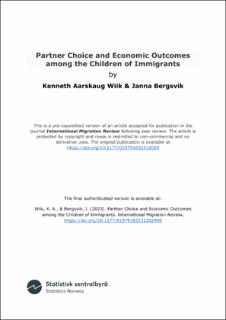| dc.contributor.author | Wiik, Kenneth Aarskaug | |
| dc.contributor.author | Bergsvik, Janna | |
| dc.date.accessioned | 2023-10-09T11:21:49Z | |
| dc.date.available | 2023-10-09T11:21:49Z | |
| dc.date.created | 2023-10-02T09:49:02Z | |
| dc.date.issued | 2023 | |
| dc.identifier.citation | International Migration Review, 2023 | en_US |
| dc.identifier.issn | 0197-9183 | |
| dc.identifier.uri | https://hdl.handle.net/11250/3095247 | |
| dc.description | This is the final text version of the article, and it may contain minor differences from the journal's pdf version. The original publication is available here: https://doi.org/10.1177/01979183231202990 | en_US |
| dc.description.abstract | Several studies have shown that immigrants marrying natives experience better economic outcomes than those marrying other immigrants, but we know less about partner choice and the economic outcomes of the children of immigrants and among those forming cohabiting unions. Utilizing Norwegian register data from all cohabiting and marital unions formed between 2006 and 2018 involving second-generation and childhood immigrants (N = 49,692 couples, 65% cohabiting), we explored how partner choice relates to employment status, individual income, and household income for up to 14 years after union formation. Overall, children of immigrants with native partners were more frequently employed and earned higher incomes than those who chose partners from migrant-backgrounds. Fixed effects model results confirmed that children of immigrants who partnered endogamously experienced less favorable employment and individual income trajectories compared to those partnering with natives. We discovered similar negative impacts on the likelihood of employment and on the individual incomes of men who partnered exogamously with migrant-background women. However, when ignoring initial selection and shifting focus solely to changes post-union formation, we found that partnering endogamously had a positive effect on household income. In general, we observed the strongest effects among women and those married, and we noticed important differences across global regions of origin. | en_US |
| dc.language.iso | eng | en_US |
| dc.publisher | Sage | en_US |
| dc.rights | Navngivelse-Ikkekommersiell-DelPåSammeVilkår 4.0 Internasjonal | * |
| dc.rights.uri | http://creativecommons.org/licenses/by-nc-sa/4.0/deed.no | * |
| dc.title | Partner Choice and Economic Outcomes among the Children of Immigrants | en_US |
| dc.title.alternative | Partner Choice and Economic Outcomes among the Children of Immigrants | en_US |
| dc.type | Peer reviewed | en_US |
| dc.type | Journal article | en_US |
| dc.description.version | acceptedVersion | en_US |
| dc.rights.holder | Sage | en_US |
| dc.subject.nsi | VDP::Sosiologi: 220 | en_US |
| dc.subject.nsi | VDP::Sociology: 220 | en_US |
| dc.source.journal | International Migration Review | en_US |
| dc.identifier.doi | 10.1177/01979183231202990 | |
| dc.identifier.cristin | 2180821 | |
| dc.relation.project | Norges forskningsråd: 250486 | en_US |
| cristin.ispublished | true | |
| cristin.fulltext | postprint | |
| cristin.qualitycode | 2 | |

